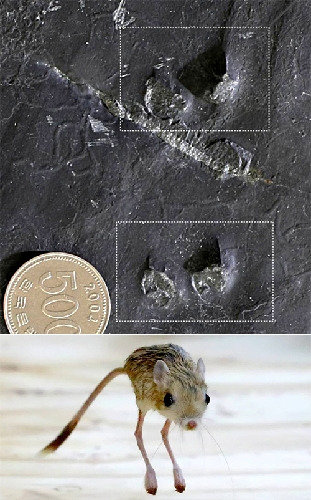Mammals lived 100 million years ago on the Korean Peninsula
Mammals lived 100 million years ago on the Korean Peninsula
Posted February. 22, 2017 07:40,
Updated February. 22, 2017 08:20

The National Research Institute of Cultural Heritage announced Tuesday, "A fossil of jumping footprints of a mammal in Cretaceous in the Mesozoic Age was found at a construction site for a detached house in Jinjoo City, South Gyeongsang Province." The site where the fossil was found is 200 meters far from the dinosaur footprint fossil site in Hotan-dong designated as National Monument No. 534.
According to research, the newly discovered footprint fossil is composed of nine pairs of hind legs, all having jumping traces. Until now, a mammal's footprint fossil in jump form had been identified in the Ameghinichnus and Musaltipes fossils.
The stratum where the fossils were found is the nacreous layer of the Cretaceous period in the Mesozoic Age, presumably 110 million years earlier. The fossil was named Koreasaltipes Jinjuensis, which means a footprint fossil found in the nacreous layer in Korea. Koreasaltipes Jinjuensis fossil is sharply different from the Ameghinichnus and Musaltipes fossils in foot form and angle.
The nine pairs of the footprints are 32.1 centimeters long in total, with each footprint just 1 centimeters on average. The institute believes that the animal's height is just about 10 centimeters considering its average stride at 4.1 centimeters. With body motion similar to that of a kangaroo mouse, the hind legs are estimated to be similar to the current kangaroo mouse.
Sang-Un Kim sukim@donga.com
Headline News
- N. Korea launches cyberattacks on S. Korea's defense companies
- Major university hospital professors consider a day off each week
- Italy suffers from fiscal deficits from ‘Super Bonus’ scheme
- Inter Milan secures 20th Serie A title, surpassing AC Milan
- Ruling and opposition prioritize spending amid tax revenue shortfalls







